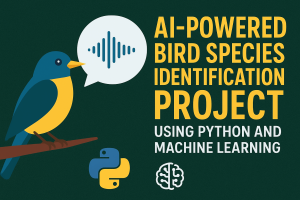Birds play a vital role in our ecosystem, serving as indicators of biodiversity and environmental health. However, accurately identifying bird species—especially through their calls—is a complex challenge for researchers.
In this blog, we’ll explore an AI-powered Bird Species Identification Project built using Python, Machine Learning, and Deep Learning. This project is inspired by the BirdCLEF 2024 dataset and leverages cutting-edge AI models to classify bird calls and provide detailed insights about each species.
This is a great AI/ML project idea for college students, combining practical coding skills with real-world applications in biodiversity and conservation.
Project Overview
The goal of this project is to develop a system that can:
- Identify bird species from audio recordings of their calls.
- Convert audio into spectrograms and use them as input for classification models.
- Provide detailed insights about each identified bird using a Retrieval-Augmented Generation (RAG) chatbot powered by AI.
By combining machine learning classification and AI-powered information retrieval, this project offers an engaging way to explore bird biodiversity.

Features & Functionality
Bird Call Classification
- Audio recordings are converted into spectrograms.
- Models like CNN and Bi-LSTM classify the species.
AI Knowledge Retrieval
- Uses a LLaMA-based RAG chatbot to explain the identified bird.
- Sources information from encyclopedias and bird guides.
Multiple Model Approaches
- Models tested include Random Forest, ANN, CNN, Bi-LSTM, and Attention-based hybrids.
- The best-performing model (CNN + Bi-LSTM + Attention) achieved ~70% accuracy.
Conservation & Education Applications
- Helps biodiversity researchers monitor ecosystems.
- Educates students and nature enthusiasts.
- Can be used in mobile/IoT-based wildlife applications.
Tools & Technologies Used
Programming & Libraries
- Python – Core language
- TensorFlow/Keras, PyTorch – Deep learning frameworks
- Librosa, OpenCV – Audio preprocessing and spectrogram generation
- Scikit-learn – ML models and evaluation
AI Models
- Random Forest, ANN, CNN
- Bi-LSTM with Attention mechanism
- CNN-BiLSTM hybrid (Best accuracy)
RAG Model & Knowledge Base
- LLaMA-based RAG Chatbot
- FAISS for vector search and embeddings
- Bird Encyclopedias and Research Papers as knowledge sources
Dataset
-
BirdCLEF 2024 Dataset – Bird calls from the Western Ghats (India’s biodiversity hotspot).
Results
- Random Forest → 47% Accuracy
- CNN → 63% Accuracy
- Bi-LSTM with Attention → 68% Accuracy
- CNN + Bi-LSTM + Attention → 70% Accuracy (Best Model)
The combination of deep learning + attention mechanisms significantly improved classification performance.
Contact to get the Source Code
Skype Id: jcodebun
Email: jcodebun@gmail.com
WhatsApp: +91 8827363777
Why is this a Great Project for Students?
✅ Covers both Machine Learning & Deep Learning concepts.
✅ Uses real-world datasets (BirdCLEF 2024).
✅ Combines classification + RAG chatbot for an innovative twist.
✅ Applicable in conservation, ecology, and education.
✅ Helps build a strong portfolio project for placements or research.
📌 Conclusion
The AI-Powered Bird Species Identification Project is a perfect blend of Python, AI, and real-world problem-solving. It not only classifies bird species from audio but also provides detailed insights through an AI chatbot.
This project demonstrates how AI can contribute to biodiversity conservation, environmental research, and education—making it an excellent choice for college students, researchers, and AI enthusiasts.
👉 If you’re looking for a unique final-year project in AI/ML, this is a strong candidate to showcase your skills and passion for technology with impact.
